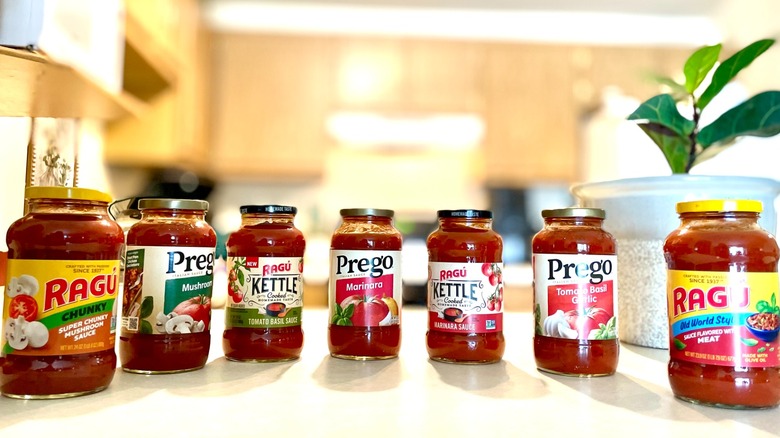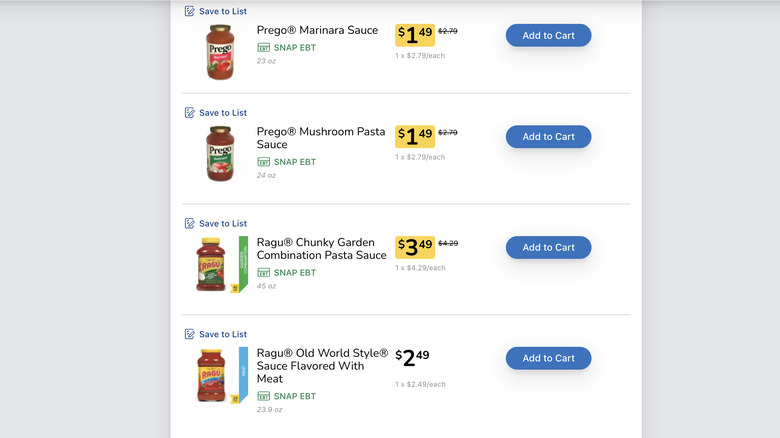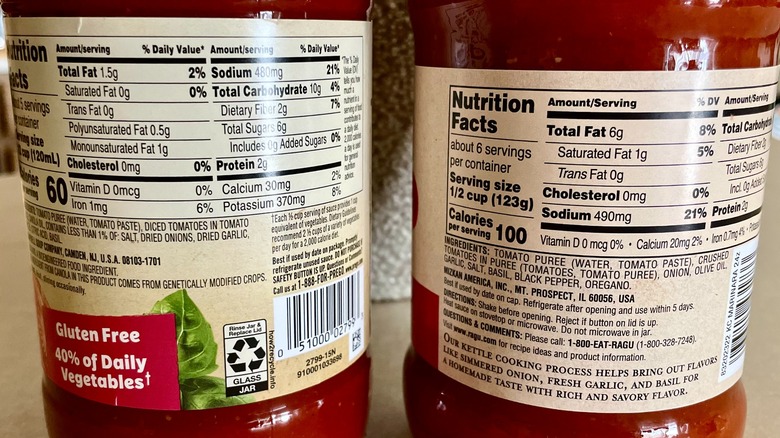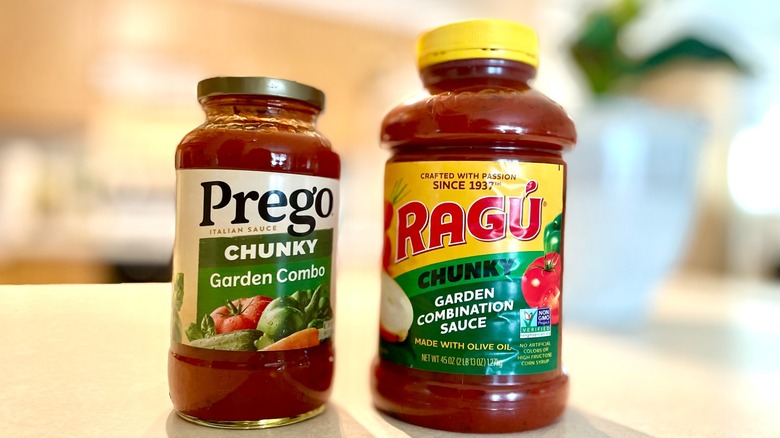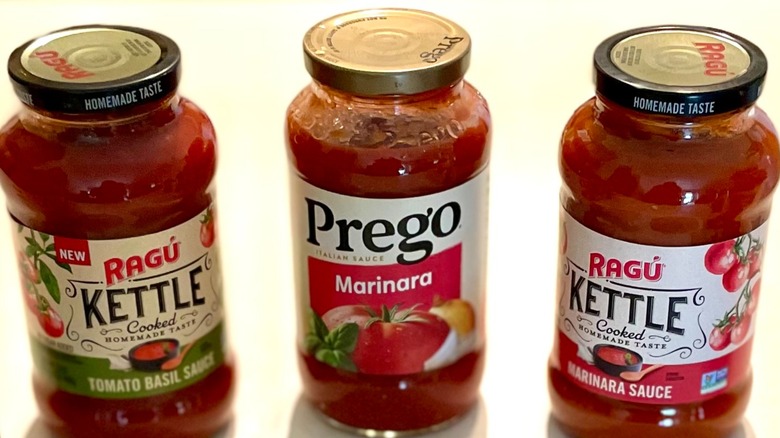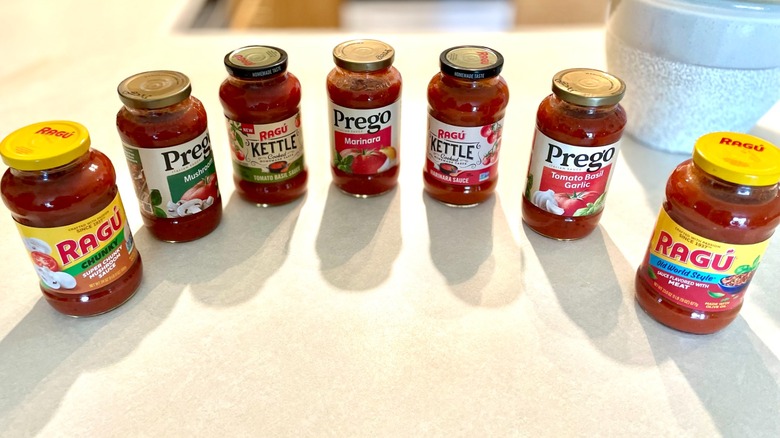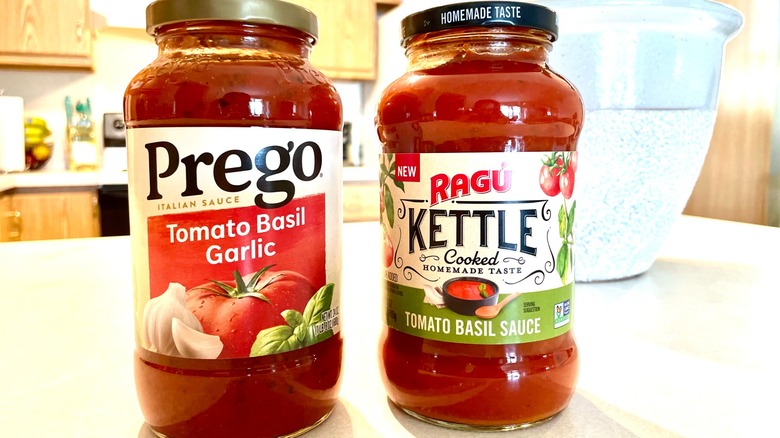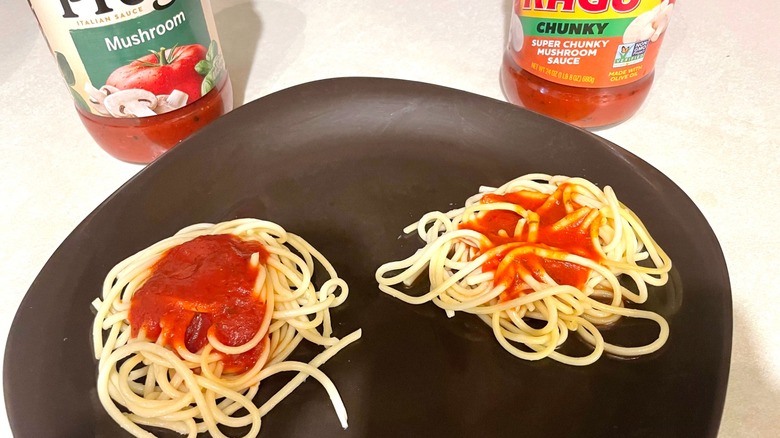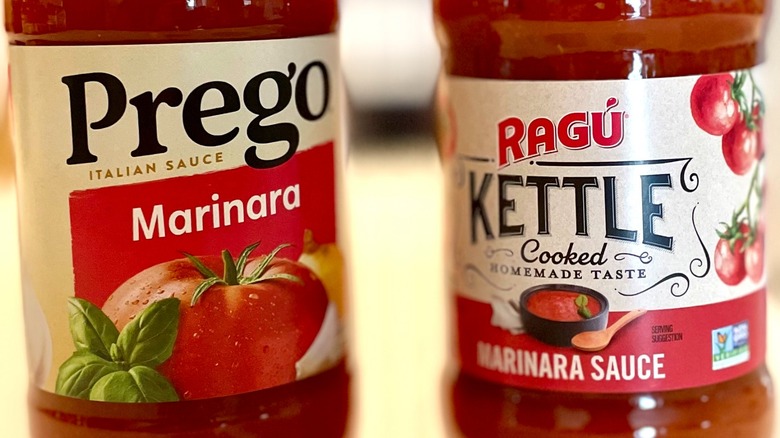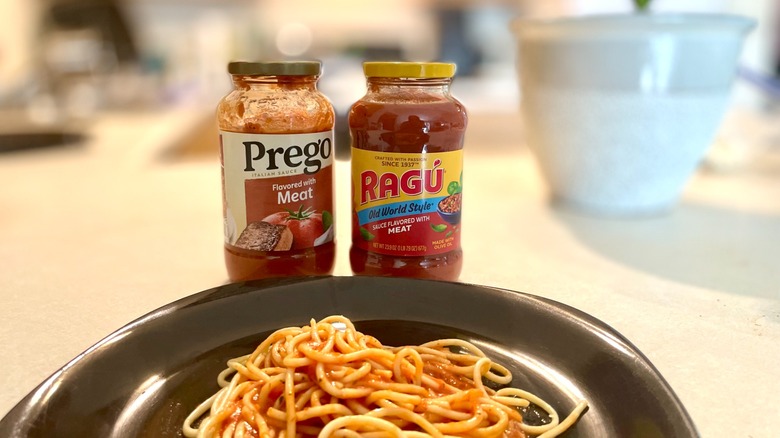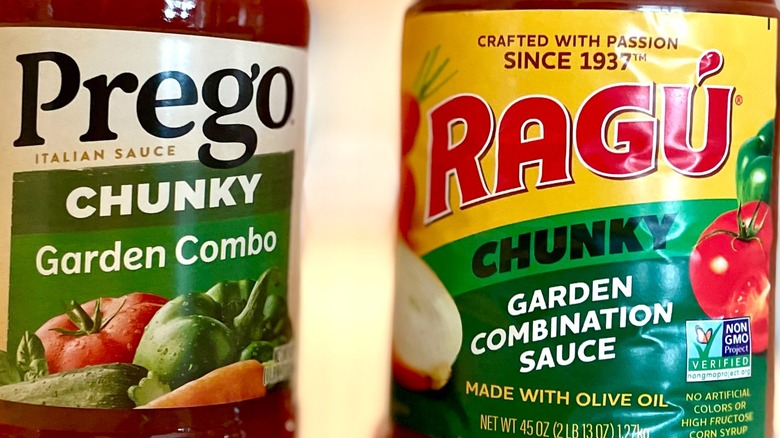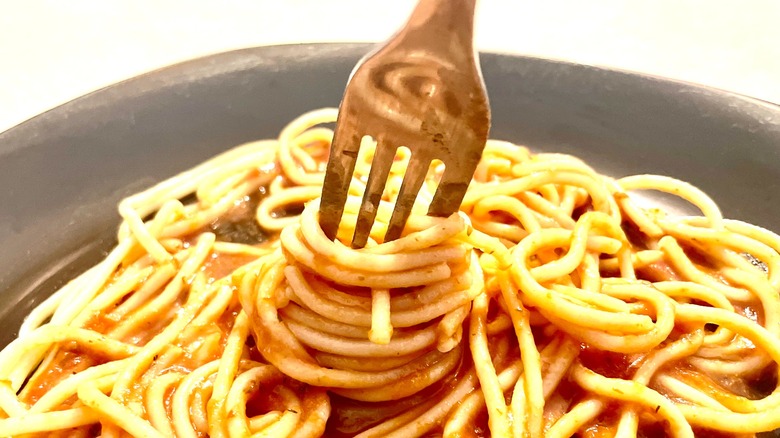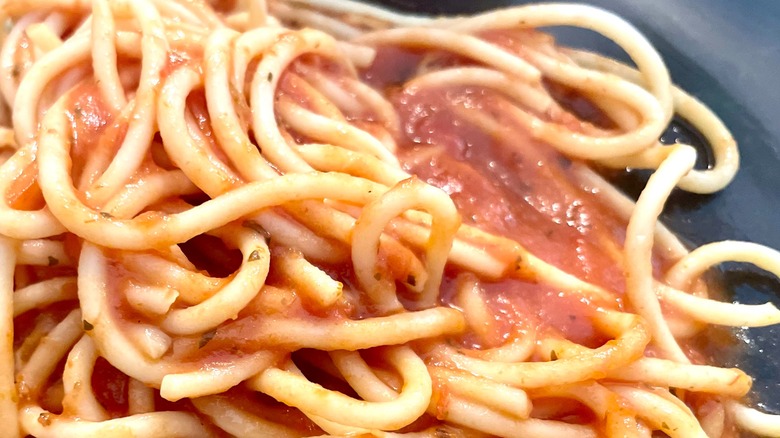Prego Vs Ragù: Which Pasta Sauce Brand Is Better?
Prego and Ragú are two pasta sauces that seem to have been around forever. I, for one, have always associated these brands with "cheap" pasta sauce, given their price points and nostalgic '90s feel. Typically, I'd make my own pasta sauce at home, but comparing Prego and Ragú against one another to see which wins out in terms of flavor, consistency, and more, intrigued me.
Let's be real: dumping sauce on noodles is the ultimate kitchen hack. And when it comes to saving time on those "I-can't-be-bothered" weekends, picking the champ among pasta sauce giants might just be the secret weapon.
In this post, I'll compare Prego and Ragú in several categories to see which of the two brands is truly better. From pricing to flavor, I'll give you the rundown on which of these brands I think is worth your time and hard-earned dollars. So, settle in and get ready for a flavorful face-off. I'm diving into the saucy world of Prego versus Ragú to dish out the verdict on which one takes the pasta crown. Stay tuned for the tasty details and how we selected our sauces.
Prego and Ragú hover around the same price (for the most part)
When it comes to comparing your standard 24-ounce jar of sauce, Ragú is cheaper than Prego ... sometimes. In my area, a jar of Prego runs about $2.79, while a jar of Ragú runs between $2.49 to $3.49, depending on the variety. On the day I picked up my sauces, both brands were running ridiculously good deals on top of their already affordable prices, and because of that, the Prego was cheaper. It felt like such a great value, especially given that others, like Rao's Homemade pasta sauce flavors, are around $8 or more per 24-ounce jar.
It is also worth noting that while most Prego jars run $2.49 or so, there may be slight discrepancies in sizing. Most standard-size Prego jars are 24 ounces, but if you look very closely, you'll notice that some varieties, like the "chunky" line or those flavored with meat, offer less in the jar giving patrons only 23.75 ounces or 23.5 ounces, respectively, for the same 24-ounce price. From what I can tell, Ragú does not mimic this trend, as it tends to offer anywhere from 23.9 ounces to 24 ounces for its standard sauce. Still, expect the brand to charge a dollar extra for "kettle-cooked" varieties and also to only receive 16 ounces for the price of a 24-ounce jar when it comes to the alfredo sauce options.
Ragú is occasionally higher in fat
When it comes to the "kettle-cooked" Ragú varieties, it is worth keeping in mind that this pasta sauce will be higher in fat than your typical Prego sauce. I compared marinara and tomato basil varieties for both Ragú and Prego and in both cases, Ragú had strangely elevated fat content at 6 grams of fat and 1 gram of saturated fat per half-cup for both the marinara and tomato basil flavors. This may be down to its olive oil content, although Prego also features canola oil in its ingredients and still only renders 1-2 grams of fat on average for the same serving size.
It should also be noted that as far as other ingredients go, neither brand differs much from the other. There aren't tons of additives in either, and both brands keep it simple with familiar ingredients like tomato purée, diced tomatoes, oils, spices, plus a hint of citric acid.
Both Prego and Ragú feature a variety of sizing options
We've already touched on sizing a bit, but let's dig a little deeper. When it comes to Prego, the sizes vary by flavor type with some flavors rendering smaller sizes for the same price as the standard sizing. Most Prego jars run about 24 ounces per jar, but some run in the 23-24 ounce range. On top of that, Prego also offers a 67-ounce bottle of its sauce, selling for around $5 (at the time of publication) at Walmart, which is totally worth it. We also spotted medium-sized 45-ounce jars sold in 3-packs at Costco, so that is an option as well.
Ragú also has larger sizes, but no 67-ounce jars are available from this brand. Instead, stores sell 24-ounce jars, 45-ounce jars, and, in the case of Walmart, even 136-ounce jars (that's 8 ½ pounds of pasta sauce)!
You should also note that while you'll tend to get tomato-based sauces for the aforementioned price points, you can expect to pay a little more for cream-based ones from both brands. Ragú's creamy sauces tend to be bottled in 16 and 21 ½ ounce jars, while Prego's cream-based varieties go for 14 ½ ounces and 22 ounces. All in all, you've got options when it comes to both brands, with sizes available for all of your saucy needs.
Ragú features a more eclectic selection
While Prego has plenty of flavors, it really only features the "chunky" version as the most remarkably different sauce offering. Although the brand also has other variations like "no sugar added", "lower sodium", and "sensitive recipe", they aren't necessarily options to get super excited about.
Ragú, on the other hand, features a wide range of interesting pasta sauce grabs. Like Prego, the company features chunky sauces, but there's more than that. Ragú has "Simply" sauces featuring fewer ingredients, "Hidden Hero" sauces stuffed full of veggies, "Old World" style sauces, and kettle-cooked varieties. So, we'd have to say that while Prego has many flavors and a few different varieties, their offerings seem to relate to health more than they do variations in flavor and cooking styles. As a result, I'd say Ragú has a more uniquely eclectic selection than what Prego tends to offer.
Both Prego and Ragú are widely available
I took to my local Pick 'n Save, owned by Kroger, to cop my Prego and Ragú pasta jars and was impressed with the selection. There were multiple flavor options available from both companies, and the 10 I chose only scratched the surface of what was available. To ensure my comparisons were fair, I selected pasta sauces that were reasonably similar from both brands. After my Pick 'n Save pasta sauce adventure, I decided to glance at Walmart's website to see what options it was offering online. Both Prego and Ragú had countless varieties available, with some flavor overlap, but several distinct brand-specific options were up for grabs as well. You'll find plenty of options at your local Walmart, Kroger, Sam's Club, Publix, and more; just note that while I did see Prego on the Costco website, I didn't see Ragú, as of the time of writing.
Prego Tomato Basil Garlic vs. Ragú Tomato Basil
First up was the tomato basil flavor from both Prego and Ragú. Going in, I expected both to capture my attention in terms of basil — the clue is in the name after all. With Prego boldly highlighting "garlic" in its name, I also naturally assumed it would pack some garlicky punch.
What I experienced was not quite what I was expecting, and this rings true concerning both brands. Upon opening Prego's Tomato, Basil, and Garlic pasta sauce, I was met with a very soupy consistency. At first blush, the sauce tasted very bright and basil-forward, as expected. However, it also featured a weird, bitter aftertaste, almost like lemon, leading to an overall unpleasant experience. I also didn't taste much of the garlic in the sauce here, which was particularly disappointing.
When it comes to Ragú Kettle-Cooked Tomato Basil sauce, I can say off the top that the flavor was more pleasant; however, it still wasn't quite what I was expecting from a "basil" flavored pasta sauce. The consistency of the Ragú was thicker (almost like crushed tomatoes), but honestly, this tasted like a standard jar of cheap pasta sauce. There was nothing special about it, and its notes of basil were hardly distinguishable. Nevertheless, I enjoyed the taste of this one more, mainly because there was no sharp aftertaste like I'd experienced with the Prego brand.
Prego Mushroom sauce vs. Ragú Super Chunky Mushroom sauce
Now, it was time for the ultimate umami showdown. I was looking forward to sampling the Prego Mushroom sauce and Ragú Super Chunky Mushroom sauce flavors given how much I love mushrooms. Upon cracking open Prego's mushroomy version of its pasta sauce, I was once again met with a very watery consistency. What threw me off with this one, though, was the flavor. This sauce tasted like nothing. It had no flavor whatsoever. And correct me if I'm wrong, but shouldn't mushroom sauces have, well, mushrooms? I saw no mushrooms during my journey with the sauce, even after dumping out almost half the jar in search of some. Alas, I couldn't find a single one, despite it being listed as an ingredient.
As for Ragú's "Super Chunky" Mushroom Sauce, it honestly made me laugh out loud. I'd label this sauce super soupy over super chunky. As for the flavor, it was tastier than Prego and provided more umami depth but didn't seem to give off any mushroom vibes. Once again, there were no mushrooms I could see. Is it too much to expect to see mushrooms in mushroom sauce? Either way, as a huge mushroom fan, I can say I was disappointed after sampling both Prego and Ragú mushroom sauces.
Prego Marinara vs Ragú Kettle-Cooked Marinara Sauce
I've had some pretty tasty marinara sauces in my day. Still, I wasn't sure what to expect coming from inexpensive brands like Prego and Ragú. What I discovered didn't surprise me, but I'm also not sure everyone will agree with my stance.
Starting with Prego, I found this marinara sauce chunkier than the watery versions of Prego I had previously sampled. For this, I was grateful. Sadly, the flavor didn't match its promising chunky texture, as it fell flat, coming off as flavorless, much like the mushroom sauce I'd sampled earlier. I expected more of a tomato-forward and bolder flavor emitting from a sauce like this, but, sadly, it left me wanting more.
Ragú's Kettle-Cooked Marinara Sauce wasn't much better, however, it did yield more in terms of flavor than the Prego sauce did. What disappointed me most about Ragú sauce was the fact that it didn't taste like anything special, especially given its fancy "kettle-cooked" label. It just tasted like any other marinara I could get on the cheap. With that said, I could see the flavor of this sauce working well as a dip for mozzarella sticks or as a pizza sauce. As for using it in a dish where the marinara is the star of the show (such as chicken lasagna or ziti), I'd recommend you bypass both brands and select a higher-quality grab instead.
Prego Meat flavored vs Ragú Old World with Meat
I wasn't expecting much coming from the meat-flavored Prego and Ragú varieties. I kept imagining little preservative-filled, age-old meat pieces floating around in the jarred sauce. Fortunately, both Prego and Ragú sauces like these are, apparently, only "flavored" with meat, according to the label, which put my mind at ease.
To start, Prego Flavored With Meat Sauce looks thicker than some of the Prego sauces I had tried before, and it tastes pretty good, too. The sauce still maintained its typical bright tomatoey taste, but this time, it was contrasted against the savory taste of meat, which, I'll admit, was nicely done. Still, I must say that this particular sauce delivered somewhat of a watery taste that washed out the flavor a bit, rendering it underwhelming. So, despite the yummy contrast between the actual sauce and the meat flavor added, this one fell flat when it came to the overall intensity of flavor.
Ragú Old World Style Sauce Flavored With Meat, on the other hand, was a real winner. At first, I was unsure given that the texture of the sauce seemed rather thin, but once I tasted it, I realized it was the perfect balance of flavor. The sauce tastes a bit like meatballs or Italian sausage and has a nice balance of herbs that make it delicious. Overall, this Ragú variety ended up being one of my favorites and definitely tastes better than Prego.
Prego Garden vs. Ragú Garden
Hearty veggies blanketed with rich and robust tomato sauce; what's not to love? Still, I wasn't sure whether Prego or Ragú would fare better in terms of taste in this variety, but I went into it with high hopes. By the end of my taste test, however, the winning brand was clear.
Beginning with Prego, I found its Chunky Garden Combo Sauce quite delightful. The sauce earned its "chunky" name with large and medium-sized veggies visible. Upon sampling this, I got a slightly oniony flavor that wasn't at all strong but instead was subdued and pleasant. The flavor was bright as usual, but it was very flavorful, much more than many of the other Prego varieties I'd tested.
Ragú Chunky Garden Combination Sauce featured a salsa-like consistency and had a deeper umami flavor, which seems to be the trend with Ragú. And while I always appreciate the depth of flavor, in this case, it didn't work well for me. I'd much rather be able to taste all the delicious flavors the veggies bring, and because Prego tends to feature a lighter flavor anyway, it worked well for this purpose. With Ragú, I felt its savory undertones masked the taste of the veggies, making it more uniform and akin to other Ragú varieties I had tried rather than standing distinctly on its own.
Prego vs. Ragú: Final verdict
When it comes to which brand is "better" between Prego and Ragú, I'd say they both come with pros and cons. Prego tends to have a lighter, brighter, more herbal taste, while Ragú tends to yield a deeper savor. Both pasta sauce brands tend to feature sauces with watery consistencies, with Ragú being the least watery of the two — most of the time. Both are pretty similar in terms of pricing, availability, and sizing, and both feature variety, although, once again, Ragú comes out on top here.
If I had to recommend one based on reliability, I'd say go for Ragú. In most cases, Ragú had the winning flavor and texture, while Prego's Chunky Garden Combo was the only one that truly impressed me. Since the pricing for these pasta sauce grabs are fairly similar, there's really no reason to bypass Ragú in favor of Prego. With all things considered, I think both pasta sauce types are plausibly decent, but in terms of which is truly better, I'd say Ragú wins out.
Methodology
Determining which is better between Prego and Ragú sauce wasn't an easy feat. Comparing pricing, availability, sizing, taste, texture, and variety were all factors in determining the winning sauce. I tend to like deep, complex flavors rather than light and herbal, so that played a major role in my critique of each sauce brand. Of course, your taste buds may differ. Ultimately, this piece was written to inform based on my opinions, given the aforementioned categories and my preference for sauce. I hope it serves to shine a little light on what you might expect from either brand and inspire you to give one — or both — a try next time you want a quick and easy pasta option.
